According to a report this month from the U.S. Chamber of Commerce, in what’s being referred to as the Great Reshuffle, there are 9.5 million job openings and only 6.5 million unemployed workers to fill them. While some point to an aging population with early retirements and an overwhelming number of business starts, the lack of available child care is partially blamed for the disappearing workforce in the United States.
Although the U.S. government distributed $24 billion in American Rescue Plan Act funding to keep child care centers open in 2021, more than 70,000 have closed since the funding ran out, according to liberal think tank The Century Foundation.
The lack of child care has been prominent in the Great Reshuffle of the U.S. workforce, defined by high hiring rates and a decreasing amount of available talent. As parents have been told to return to the office, some very tough decisions have had to be made at home.
“The cost of daycare is tremendously expensive now. I don’t know where the break-even point is exactly, but it’s probably around $50,000 to $60,000, or you might as well not be working if you have to pay for it,” Todd Surline, president of Hiring Solutions and an adjunct professor at Michigan State University who teaches strategic staffing, told the Epoch Times.
“It’s not a work ethic issue. Employees today just want different things.
“It also isn’t the money; it’s the flexibility. Employers have to be more flexible.”
In its 2024 Trend Report, Ford Motor Co. surveyed its massive workforce and found that 52 percent of its employees globally would be willing to take a 20 percent pay cut for a better work–life balance. Ford’s U.S. employees who were ready to take a pay cut were led by Generation Z (born between 1997 and 2012) at 56 percent.
According to the U.S. Chamber study, women are participating in the labor force at the lowest rates since they began leaving home for work in the 1970s. During the pandemic, 3.5 million mothers left their jobs, driving the labor force participation rate for working moms from about 70 percent to about 55 percent. Many never came back.
“The pandemic should have told us something, and we had our blinders on and didn’t pay attention to what we learned,“ Linda K. Smith, director of the Early Childhood Initiative in Washington, told The Epoch Times. ”The school systems closed, and the teachers got paid. But child care centers closed, and they weren’t paid, and their teachers got laid off.
“The government may have stepped in and tried to shore up child care, but still, they didn’t help with the parents’ side of the equation with financial support to help pay for child care.”
Ms. Smith also believes that hybrid work schedules have been counterproductive to solving the daycare issue.
“If you’re working remotely two days a week, your child care becomes sporadic, and most centers need to be paid full time, or they can’t make the numbers work,” she said.
“There aren’t many [daycare centers] that will take a child two or three days a week. It’s creating havoc for parents.
“What we have found in our own surveys is that 38 percent quit a job because of child care, and 30 percent left the workforce because of child care.”
The lack of affordable child care support has cost the U.S. economy $122 billion per year, affecting working parents, their employers, and the nation’s taxpayers, according to a study released in February 2023 by ReadyNation. Part of The Council for a Strong America, ReadyNation stated that companies in the United States “need to recognize childcare as a business-critical issue and implement supportive policies to retain and recruit valuable talent.”
However, the rising expense for parents keeps many at home and out of the workforce altogether. A Bank of America study, released in October 2023, found that the average U.S. household spent more than $700 per month on child care—up by 32 percent from 2019. Many families are going into their savings to pay for it, burdening economic growth.
“Child care for a 4-year-old is around $12,000 to $14,000 a year, so if you’re making $15 an hour, that’s a lot of your pay, and you’re not using it because you can’t afford it,” Ms. Smith said. “In places like Washington, D.C., you pay $24,000 to $25,000 a year for an infant. It’s expensive because infants are labor intensive.
“Plus, these programs are only open 10 hours a day. It’s a lot more complicated than I think most people understand and are willing to address.”
The U.S. Chamber study found that nearly half (49 percent) of their respondents said they aren’t willing to take a job that doesn’t offer remote work, with more than a quarter (26 percent) saying it'll never again be essential for them to return to work.
Mr. Surline, who has been working in personnel and human resources capacities since 1983, said employers today need a different mindset to fill positions and not just regarding remote work options.
“If I have a client struggling to get applicants, I try and talk to them about flexibility for employees, like taking an afternoon off or leaving early to go to a soccer game or a sick family member,“ he said. ”Being flexible in this job market makes a huge difference.”





